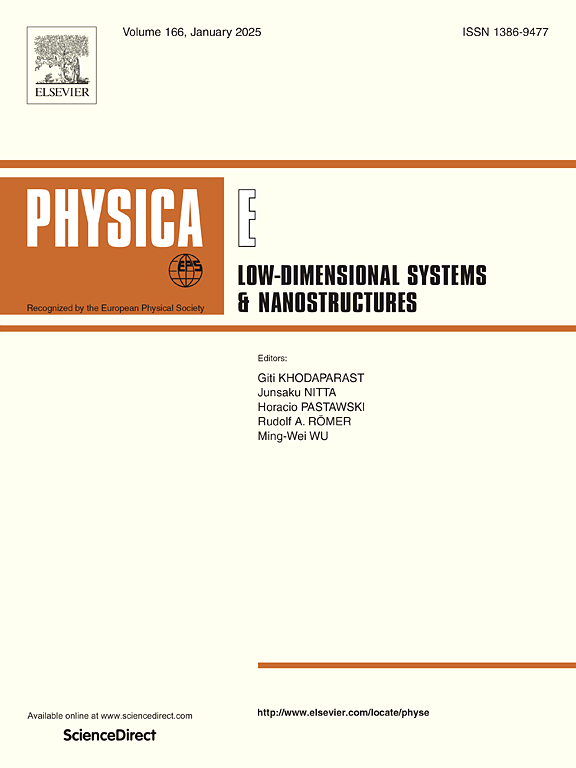Post growth annealing of Ga1-xInxNyAs1-y/GaAs double quantum well structures grown on (100), (311)A, and (311)B GaAs substrates
IF 2.9
3区 物理与天体物理
Q3 NANOSCIENCE & NANOTECHNOLOGY
Physica E-low-dimensional Systems & Nanostructures
Pub Date : 2024-09-24
DOI:10.1016/j.physe.2024.116109
引用次数: 0
Abstract
The effect of thermal annealing on the optical properties of In0.36Ga0.64As1-yNy/GaAs double quantum wells (QWs) grown on different GaAs planes was investigated for two sets of samples having y = 0 % and 1 % nitrogen. It was found that annealing at 700 °C for 30 seconds is the optimum annealing temperature which improves the photoluminesces (PL) efficiency for all QWs. The PL enhancement is larger in samples with 1 % nitrogen than 0 %. This PL improvement, which may be explained by the annihilation of defects introduced by the incorporation of nitrogen, is accompanied by a blue shift. Secondary ion mass spectroscopy (SIMS) shows that In/Ga intermixing, which occurs at the interface between QW and barrier, could account for the origin of this energy shift in QWs grown on (311)A and (100) planes. The amount of diffusion of In out of the QW depends on the growth plane. It is larger for QWs grown on (311)B plane as compared to the other planes. However, in contrast to the (311)B QWs the nitrogen content in the (100) and (311)A QWs doesn't change upon annealing.
在 (100)、(311)A 和 (311)B GaAs 基底上生长的 Ga1-xInxNyAs1-y/GaAs 双量子阱结构的生长后退火
研究了热退火对生长在不同砷化镓平面上的 In0.36Ga0.64As1-yNy/GaAs 双量子阱(QWs)光学特性的影响。研究发现,在 700 °C 下退火 30 秒是最佳退火温度,可提高所有 QW 的光致发光(PL)效率。含氮量为 1% 的样品比含氮量为 0% 的样品的光致发光增强幅度更大。这种光致发光的改善可能是由于氮的加入导致了缺陷的湮灭,同时还伴随着蓝移。二次离子质谱 (SIMS) 显示,在 QW 和势垒之间的界面上发生的 In/Ga 互混可能是在 (311)A 和 (100) 平面上生长的 QW 中产生这种能量偏移的原因。铟扩散出 QW 的量取决于生长平面。与其他平面相比,生长在 (311)B 平面上的 QW 的 In 扩散量更大。然而,与 (311)B QW 不同的是,(100) 和 (311)A QW 中的氮含量在退火后不会发生变化。
本文章由计算机程序翻译,如有差异,请以英文原文为准。
求助全文
约1分钟内获得全文
求助全文
来源期刊
CiteScore
7.30
自引率
6.10%
发文量
356
审稿时长
65 days
期刊介绍:
Physica E: Low-dimensional systems and nanostructures contains papers and invited review articles on the fundamental and applied aspects of physics in low-dimensional electron systems, in semiconductor heterostructures, oxide interfaces, quantum wells and superlattices, quantum wires and dots, novel quantum states of matter such as topological insulators, and Weyl semimetals.
Both theoretical and experimental contributions are invited. Topics suitable for publication in this journal include spin related phenomena, optical and transport properties, many-body effects, integer and fractional quantum Hall effects, quantum spin Hall effect, single electron effects and devices, Majorana fermions, and other novel phenomena.
Keywords:
• topological insulators/superconductors, majorana fermions, Wyel semimetals;
• quantum and neuromorphic computing/quantum information physics and devices based on low dimensional systems;
• layered superconductivity, low dimensional systems with superconducting proximity effect;
• 2D materials such as transition metal dichalcogenides;
• oxide heterostructures including ZnO, SrTiO3 etc;
• carbon nanostructures (graphene, carbon nanotubes, diamond NV center, etc.)
• quantum wells and superlattices;
• quantum Hall effect, quantum spin Hall effect, quantum anomalous Hall effect;
• optical- and phonons-related phenomena;
• magnetic-semiconductor structures;
• charge/spin-, magnon-, skyrmion-, Cooper pair- and majorana fermion- transport and tunneling;
• ultra-fast nonlinear optical phenomena;
• novel devices and applications (such as high performance sensor, solar cell, etc);
• novel growth and fabrication techniques for nanostructures

 求助内容:
求助内容: 应助结果提醒方式:
应助结果提醒方式:


